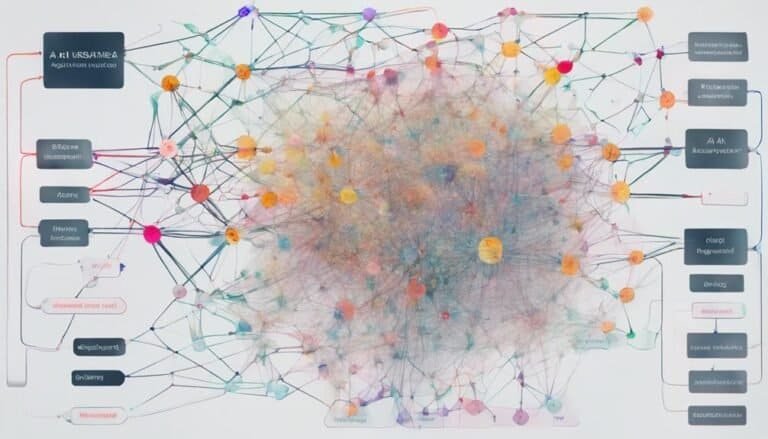Low-Code and No-Code AI: A Comprehensive Overview
Have you ever considered the possibility of harnessing the power of AI without delving into complex coding languages?
The world of low-code and no-code AI is rapidly evolving, offering a glimpse into a future where building and deploying AI models could be simplified for a wider audience.
As you explore the nuances of this transformative technology landscape, you’ll uncover a multitude of benefits and possibilities that could reshape the way we interact with artificial intelligence.
Key Takeaways
- Low-code and no-code AI tools streamline application development for users with varying technical expertise.
- Integration capabilities enable seamless data connectivity and analysis from diverse sources.
- Customization and automation options enhance AI model accuracy and efficiency without extensive coding.
- User-friendly interfaces and rapid prototyping facilitate agile development and quick deployment of AI solutions.
Evolution of AI Development Tools
The evolution of AI development tools has streamlined the process of creating intelligent applications by integrating advanced functionalities. In recent years, market trends have shown a significant shift towards the adoption of low-code and no-code platforms for AI development. These platforms offer a more accessible approach to AI application development, allowing individuals with varying levels of technical expertise to create sophisticated AI solutions.
One of the key aspects of this evolution is the democratization of AI. Traditional AI development required specialized knowledge in programming languages such as Python or R, as well as a deep understanding of machine learning algorithms. However, with the emergence of low-code and no-code AI tools, individuals with limited coding experience can now leverage pre-built components and drag-and-drop interfaces to build AI applications.
Moreover, market trends indicate a growing demand for AI solutions across industries, from healthcare to finance to retail. This has led to an increased focus on making AI development more accessible and user-friendly, driving the rapid evolution of AI development tools towards more intuitive and efficient platforms.
Benefits of Low-Code AI
Experience streamlined AI application development through the efficiency and accessibility offered by low-code platforms. Low-Code AI presents various benefits, including flexible deployment strategies, enhanced model accuracy, scalability options, and seamless integration capabilities.
When it comes to deployment strategies, low-code platforms simplify the process by providing pre-built components and automation tools that enable you to deploy AI models quickly and efficiently. These platforms offer intuitive interfaces that allow for easy configuration and customization, reducing the time and effort required for deployment.
Moreover, low-code AI solutions focus on optimizing model accuracy by leveraging advanced algorithms and automated workflows. These platforms facilitate model training and tuning, ensuring that your AI models deliver precise and reliable results.
In terms of scalability options, low-code AI platforms offer the flexibility to scale your applications as needed. Whether you are handling a small project or a large-scale deployment, these platforms provide the resources and infrastructure to support your growing AI initiatives.
Furthermore, integration capabilities are a key advantage of low-code AI platforms. These tools seamlessly integrate with existing systems and technologies, allowing you to leverage your current infrastructure and data sources. This integration ensures that your AI applications work harmoniously within your ecosystem, enhancing overall efficiency and productivity.
| Benefits of Low-Code AI | ||
|---|---|---|
| Deployment Strategies | Model Accuracy | Scalability Options |
| Integration Capabilities |
Advantages of No-Code AI
Harness the efficiency and accessibility of no-code AI to streamline the development process for AI applications effortlessly. No-code AI platforms offer several advantages that make them a compelling choice for rapid deployment and ease of use:
- Low Barrier to Entry: No-code AI tools eliminate the need for extensive coding knowledge, allowing individuals with varying technical backgrounds to create AI applications. This ease of use democratizes AI development, making it accessible to a broader audience.
- Accelerated Development: By removing the coding complexities, no-code AI expedites the development cycle. With intuitive interfaces and pre-built components, you can quickly prototype, test, and deploy AI solutions, significantly reducing time-to-market.
- Increased Productivity: No-code AI empowers business users, domain experts, and data analysts to directly participate in the AI development process. This collaborative approach boosts productivity by enabling cross-functional teams to work together efficiently.
- Iterative Improvement: The visual nature of no-code AI platforms facilitates iterative improvements and quick modifications to AI models. Users can easily tweak parameters, test different scenarios, and refine their models without extensive reprogramming, fostering continuous enhancement.
Incorporating no-code AI into your workflow can revolutionize how AI applications are developed, offering a user-friendly and agile approach to building sophisticated AI solutions.
Integration Capabilities
Integrating no-code AI platforms into existing systems enhances operational efficiency and expands the scope of AI applications within organizations. One key aspect of integration capabilities is data connectivity. No-code AI platforms offer seamless integration with various data sources, enabling you to access and analyze data from different systems without the need for complex coding. This streamlined data connectivity ensures that your AI models have access to the most up-to-date and diverse datasets, enhancing the accuracy and effectiveness of your AI applications.
When considering integration solutions for your organization, it’s essential to choose a no-code AI platform that offers robust integration capabilities. Look for platforms that support integrations with popular data sources, such as cloud storage services, databases, and APIs. Additionally, ensure that the platform provides easy-to-use tools for connecting to and extracting data from these sources.
Customization Options
When customizing AI models, you can tailor them to fit your specific needs by adjusting parameters and algorithms.
User-friendly interfaces enable you to easily navigate through customization options without extensive coding knowledge.
Configurable automation tools provide the flexibility to automate tasks according to your unique requirements.
TAIlored AI Models
Customizing AI models allows you to tailor the system to meet specific requirements or preferences. When creating tailored AI models, you have the flexibility to design solutions that precisely align with your unique needs. This level of customization empowers you to develop personalized algorithms that cater to your specific use case. By leveraging this feature, you can enhance the accuracy and efficiency of your AI applications.
Here are some key aspects to consider when customizing AI models:
- Data Selection: Choose the most relevant data sets for training your personalized algorithms.
- Feature Engineering: Create custom features that capture the unique characteristics of your problem domain.
- Hyperparameter Tuning: Optimize the model’s parameters to improve its performance.
- Model Architecture: Design a customized architecture that suits your specific requirements.
User-Friendly Interfaces
To enhance the user experience and provide greater flexibility in AI model customization, exploring user-friendly interfaces with a wide array of customization options can significantly improve the overall performance of your tailored AI models.
User-friendly interfaces play a crucial role in facilitating seamless interactions between users and AI systems. These interfaces offer intuitive design elements, drag-and-drop functionalities, and customizable features that empower users to fine-tune their AI models without extensive coding knowledge.
Configurable Automation Tools
Configurable automation tools offer a wide range of customization options to enhance the adaptability and efficiency of AI systems. These tools provide a way to tailor workflows and integrate advanced analytics seamlessly.
When using configurable automation tools, you can leverage intelligent automation capabilities to streamline processes and achieve optimal results. The ability to incorporate predictive insights into your AI systems allows for proactive decision-making and improved performance.
By customizing workflows, you can ensure that the automation tools align with your specific needs and business objectives, making the most of the technology at hand.
- Tailor workflows to specific requirements
- Integrate advanced analytics seamlessly
- Leverage intelligent automation for streamlined processes
- Incorporate predictive insights for proactive decision-making
User-Friendly Interfaces
User-Friendly interfaces in low-code and no-code AI platforms provide intuitive tools for users to easily interact with and customize artificial intelligence solutions without the need for extensive coding knowledge. The intuitive design of these interfaces focuses on enhancing the user experience through simplified workflows and visual aids. By incorporating drag-and-drop functionalities, pre-built templates, and clear navigation menus, these platforms enable users to seamlessly create, train, and deploy AI models.
Intuitive design plays a crucial role in lowering the entry barriers for individuals with varying levels of technical expertise. By offering user-friendly interfaces, low-code and no-code AI platforms empower users to engage with complex AI algorithms in a user-centric manner. These interfaces feature interactive elements that guide users through the AI development process, making it accessible to a wider audience.
User experience enhancements within these platforms include real-time feedback mechanisms, contextual help tooltips, and responsive design elements. These features ensure that users can easily troubleshoot issues, access relevant documentation, and work on their AI projects across different devices. Overall, the emphasis on user-friendly interfaces in low-code and no-code AI platforms signifies a shift towards democratizing AI development and fostering innovation in diverse fields.
Rapid Prototyping Solutions
Rapid prototyping solutions in the realm of low-code and no-code AI platforms offer streamlined processes for swiftly creating and testing AI models. These solutions leverage agile development methodologies to enhance efficiency in the AI model development lifecycle. By incorporating rapid deployment strategies, users can promptly iterate on their models, leading to quicker innovation and adaptation to changing requirements.
Key Aspects of Rapid Prototyping Solutions:
- Agile Development: Embracing agile principles allows for iterative development cycles, fostering collaboration and adaptability throughout the AI model creation process.
- Rapid Deployment: Quick deployment of AI models enables faster feedback loops, facilitating timely adjustments and enhancements to improve model performance.
- Efficient Testing: Implementing robust testing procedures ensures the reliability and accuracy of AI models, guaranteeing their effectiveness in real-world applications.
- Seamless Integration: Seamless integration capabilities streamline the incorporation of AI models into existing systems, promoting interoperability and scalability across different platforms.
Cost-Effectiveness in Implementation
Implementing cost-effective strategies in the deployment of AI models is essential for optimizing resource utilization and maximizing return on investment in low-code and no-code AI platforms. When considering implementation efficiency and cost-effectiveness, businesses can achieve significant operational savings in AI deployment.
To enhance cost-effectiveness, it’s crucial to leverage low-code and no-code AI solutions that streamline the development and deployment processes. These platforms offer pre-built modules and templates that reduce the need for extensive coding, thereby saving time and resources during implementation. By utilizing these tools, organizations can accelerate the deployment of AI models while minimizing associated costs.
Furthermore, the automation capabilities of low-code and no-code AI platforms contribute to operational savings by reducing the reliance on manual intervention. Automated processes enhance efficiency, lower the risk of errors, and enable businesses to reallocate human resources to more strategic tasks. This shift not only drives cost-effectiveness but also improves overall productivity in AI deployment.
Industry-Specific Applications
When exploring industry-specific applications of low-code and no-code AI solutions, it becomes crucial to tailor the technology to meet the unique requirements and challenges of diverse sectors. Customized solutions are key in ensuring that these technologies align with the specific needs of industries.
Here are some industry trends to consider:
- Healthcare Sector: Implementing AI solutions in healthcare can streamline patient data management, improve diagnostics through image analysis, and enhance personalized treatment plans.
- Financial Services: Customized AI can optimize fraud detection processes, automate risk assessment, and personalize customer financial recommendations.
- Retail Industry: Utilizing AI in retail can enhance customer experience through personalized recommendations, optimize inventory management, and forecast demand more accurately.
- Manufacturing Sector: AI applications in manufacturing can improve predictive maintenance processes, enhance quality control through image analysis, and optimize supply chain management for increased efficiency.
Collaboration Features
When looking at collaboration features in low-code and no-code AI tools, you’ll find real-time team updates that facilitate seamless communication.
With shared project dashboards, team members can stay informed about progress and contribute effectively to the project.
These features enhance teamwork and productivity by providing a centralized platform for collaboration.
Real-Time Team Updates
Leverage real-time team updates in your collaborative environment to enhance communication and streamline project progress. By integrating real-time performance tracking tools, you can boost team productivity significantly. Here’s how this feature can benefit you:
- Instant Feedback: Receive immediate input on tasks and address issues promptly.
- Enhanced Coordination: Keep everyone on the same page by sharing updates in real time.
- Improved Decision-Making: Access up-to-date information for better-informed choices.
- Increased Accountability: Track individual contributions and monitor project milestones effectively.
Embracing real-time team updates fosters a dynamic workflow, promotes transparency, and ensures that your team operates at its peak efficiency levels.
Shared Project Dashboards
Shared project dashboards provide a centralized platform for team members to access real-time project data and collaborate efficiently. These dashboards enhance team collaboration by offering a single space where members can view project progress, assign tasks, and share updates.
Through intuitive data visualization, such as graphs, charts, and progress trackers, team members gain a comprehensive understanding of the project status at a glance. The interactive nature of these dashboards allows for seamless communication and real-time updates, fostering a collaborative environment where team members can work together towards common goals.
Scalability and Flexibility
To ensure successful implementation of low-code and no-code AI solutions, it’s crucial to assess their scalability and flexibility in adapting to evolving business needs and demands. Scalability challenges can arise when dealing with a growing volume of data or an increasing number of users interacting with the AI system. Flexible deployment options play a significant role in addressing these challenges.
- Vertical Scalability: Evaluate the system’s capability to handle increased workload by adding more resources like CPU, RAM, or storage vertically within the same server.
- Horizontal Scalability: Assess the system’s ability to distribute the workload across multiple servers to improve performance and accommodate growing demands seamlessly.
- Cloud Deployment: Consider deploying the AI solution on cloud platforms like AWS, Azure, or Google Cloud for enhanced scalability, flexibility, and cost-effectiveness.
- Containerization: Explore container technologies like Docker or Kubernetes to encapsulate the AI application, making it easier to deploy, scale, and manage across different environments.
Automated Model Deployment
Assess the automated model deployment process within low-code and no-code AI systems to streamline the integration of machine learning models into production environments effectively. Automated deployment strategies play a crucial role in ensuring seamless transitions from model development to deployment. One key aspect is model versioning techniques, which help in tracking changes, facilitating collaboration, and ensuring reproducibility.
Automated deployment strategies encompass various elements such as continuous integration/continuous deployment (CI/CD) pipelines, containerization, and orchestration tools. CI/CD pipelines automate the building, testing, and deploying of models, enabling rapid iterations and reducing manual errors. Containerization, using technologies like Docker, encapsulates models and their dependencies, ensuring consistency across different environments. Orchestration tools like Kubernetes manage the deployment and scaling of model containers efficiently.
Model versioning techniques are essential for maintaining a history of model iterations, enabling easy rollback to previous versions if needed. Version control systems like Git help in tracking changes, comparing models, and collaborating effectively within teams. By adopting a structured approach to model versioning, organizations can ensure traceability and reproducibility of deployed models.
Data Integration Possibilities
Exploring the potential for seamless data integration within low-code and no-code AI systems is essential for optimizing model performance and decision-making processes. When considering data integration possibilities, real-time data and seamless integration are crucial components to ensure the efficiency and accuracy of AI systems.
- Real-time Data Processing: Incorporating real-time data streams allows for immediate insights and faster decision-making based on the most up-to-date information available.
- Seamless Integration Across Platforms: Ensuring seamless integration across various platforms and systems enables a cohesive flow of data, reducing errors and improving overall system performance.
- Data Transformation Capabilities: Having the ability to transform data efficiently within the AI system enhances data quality and ensures that the information is in the most suitable format for analysis.
- Automated Data Pipelines: Implementing automated data pipelines streamlines the process of collecting, processing, and integrating data, reducing manual effort and potential errors.
AI Model Monitoring Tools
Monitoring the performance of AI models is crucial for ensuring their accuracy and reliability in real-world applications. AI model monitoring tools play a vital role in this process by providing real-time analytics and anomaly detection capabilities. These tools allow you to track the performance of your AI models continuously, enabling you to identify issues promptly and take corrective actions.
Real-time analytics provided by these monitoring tools give you instant insights into how your AI models are performing. You can monitor key metrics such as accuracy, precision, recall, and F1 score in real time, allowing you to detect any deviations from expected behavior quickly. By having access to real-time analytics, you can make informed decisions about whether your AI models are meeting the desired performance standards.
Anomaly detection is another critical feature offered by AI model monitoring tools. These tools use advanced algorithms to identify unusual patterns or outliers in the behavior of your AI models. By detecting anomalies early, you can investigate the root causes of issues and prevent potential failures before they impact your applications.
Future Trends and Innovations
As you explore the future trends and innovations in AI, consider the emergence of new technologies like quantum computing and federated learning. These advancements are poised to revolutionize various industries, from healthcare to finance, by enhancing data analysis capabilities and decision-making processes.
However, it’s crucial to also address the ethical considerations surrounding the use of AI to ensure responsible and unbiased applications in the future.
Emerging AI Technologies
One of the most anticipated advancements in artificial intelligence is the integration of federated learning into various AI applications. This technology allows multiple parties to collaborate in building a common AI model without sharing sensitive data. It helps in preserving data privacy while still benefiting from collective intelligence.
In addition to federated learning, several other emerging AI technologies are shaping the future landscape:
- Explainable AI (XAI): Enhancing transparency and interpretability of AI systems.
- Quantum Machine Learning: Leveraging quantum computing for complex AI tasks.
- AI-Powered Cybersecurity: Using AI to detect and respond to cyber threats effectively.
- Neuromorphic Computing: Mimicking the human brain’s architecture for efficient AI processing.
Impact on Industries
The integration of emerging AI technologies, such as Explainable AI, Quantum Machine Learning, AI-Powered Cybersecurity, and Neuromorphic Computing, is poised to revolutionize various industries by enhancing efficiency, security, and decision-making capabilities.
Industry transformation driven by AI is leading to a paradigm shift in how businesses operate. Companies adopting these technologies gain competitive advantages through automation of complex processes, predictive analytics for informed decision-making, and enhanced cybersecurity measures to protect sensitive data.
In sectors like healthcare, AI streamlines patient care with predictive diagnostics, while in finance, it optimizes trading strategies. The ability of AI to analyze vast datasets in real-time provides businesses with actionable insights, enabling proactive responses to market trends and customer needs.
Embracing AI is becoming imperative for staying ahead in today’s dynamic business landscape.
Ethical Considerations
Ethical considerations in the realm of AI innovations and future trends demand a meticulous analysis of potential impacts on society, ensuring responsible deployment and mindful decision-making in technological advancements. When addressing data privacy and algorithm bias, it’s crucial to prioritize these aspects to uphold ethical standards.
- Data Privacy: Implement stringent measures to safeguard personal information.
- Algorithm Bias: Regularly audit algorithms to identify and rectify biases.
- Transparency: Ensure transparency in AI systems to build trust with users.
- Accountability: Establish clear accountability structures for AI decision-making processes.
Conclusion
In conclusion, the landscape of AI development tools has evolved significantly, offering a plethora of benefits such as streamlined processes and efficient model deployment.
The integration capabilities and customization options provide a canvas for innovation, akin to a blank canvas awaiting the strokes of a master artist.
With automated model deployment and data integration possibilities, the future of AI development is poised for continuous growth and advancement, paving the way for groundbreaking innovations in the field.







